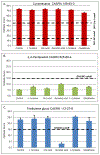Modeling the antioxidant properties of the eye reduces the false-positive rate of a nonanimal eye irritation test (OptiSafe)
- PMID: 34216722
- PMCID: PMC8522283
- DOI: 10.1016/j.tiv.2021.105208
Modeling the antioxidant properties of the eye reduces the false-positive rate of a nonanimal eye irritation test (OptiSafe)
Abstract
We recently identified a group of chemicals that are misclassified by most, if not all, in vitro alternative ocular irritation tests, suggesting that nonanimal tests may not fully model the ocular environment in which these chemicals interact. To address this, we evaluated the composition of tears, the first defense against foreign substances, and identified the presence of antioxidants that could detoxify reactive chemicals that otherwise may be falsely identified as irritants in alternative irritation tests. In this study, we evaluated the effects of tear antioxidants on the ocular irritation scoring of commonly overclassified chemicals (false positives) using the OptiSafe™ ocular irritation test. Six tear-related antioxidants were individually added to the OptiSafe formulation, and the effects on test outcome were determined. Ascorbic acid, the most abundant water-soluble antioxidant in tears, specifically reduced the OptiSafe false-positive rate. Titration curves showed that this reduction occurs at in vivo concentrations and is specific to chemicals identified either as producing reactive oxygen species or as crosslinkers. Importantly, the addition of tear antioxidants did not impact the detection of true negatives, true positives, or other false positives unassociated with reactive oxygen species or crosslinking. These results suggest that the addition of tear antioxidants to in vitro alternative test systems may substantially reduce the false-positive rate and improve ocular irritant detection.
Keywords: Antioxidants; Eye irritation; False positive; Tear.
Copyright © 2021. Published by Elsevier Ltd.
Conflict of interest statement
Declaration of interests
The authors declare that they have no known competing financial interests or personal relationships that could have appeared to influence the work reported in this paper.
Figures



References
-
- Alépée N, Adriaens E, Abo T, Bagley D, Desprez B, Hibatallah J, Mewes K, Pfannenbecker U, Sala À, Van Rompay AR, Verstraelen S, McNamee P (2019a). “Development of a defined approach for eye irritation or serious eye damage for liquids, neat and in dilution, based on cosmetics Europe analysis of in vitro STE and BCOP test methods”. Toxicol In Vitro. 57:154–163. doi: 10.1016/j.tiv.2019.02.019. - DOI - PubMed
-
- Alépée N, Adriaens E, Abo T, Bagley D, Desprez B, Hibatallah J, Mewes K, Pfannenbecker U, Sala À, Van Rompay AR, Verstraelen S, McNamee P (2019b). “Development of a defined approach for eye irritation or serious eye damage for neat liquids based on cosmetics Europe analysis of in vitro RhCE and BCOP test methods”. Toxicol In Vitro. 59:100–114. doi: 10.1016/j.tiv.2019.04.011. - DOI - PubMed
-
- AlKahtane AA, Ghanem E, Bungau SG, Alarifi S, Ali D, AlBasher G, Alkahtani S, Aleya L, Abdel-Daim MM (2020). “Carnosic acid alleviates chlorpyrifos-induced oxidative stress and inflammation in mice cerebral and ocular tissues”. Environmental Science and Pollution Research. 27:11663–11670. doi: 10.1007/s11356-020-07736-1. - DOI - PubMed
-
- Babizhayev MA (2016). “Generation of reactive oxygen species in the anterior eye segment. Synergistic codrugs of N-acetylcarnosine lubricant eye drops and mitochondria-targeted antioxidant act as a powerful therapeutic platform for the treatment of cataracts and primary open-angle glaucoma”. BBA Clin. 6:49–68. doi:10.1016/j.bbacli.2016.04.004 - DOI - PMC - PubMed

